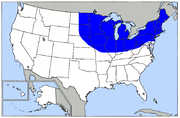
Frost Belt
Encyclopedia

United States
The United States of America is a federal constitutional republic comprising fifty states and a federal district...
generally considered to include the Northeastern United States
Northeastern United States
The Northeastern United States is a region of the United States as defined by the United States Census Bureau.-Composition:The region comprises nine states: the New England states of Connecticut, Maine, Massachusetts, New Hampshire, Rhode Island and Vermont; and the Mid-Atlantic states of New...
, the Great Lakes Region
Great Lakes region (North America)
The Great Lakes region of North America, occasionally known as the Third Coast or the Fresh Coast , includes the eight U.S. states of Illinois, Indiana, Michigan, Minnesota, New York, Ohio, Pennsylvania and Wisconsin as well as the Canadian province of Ontario...
, and much of the Upper Midwest
Upper Midwest
The Upper Midwest is a region in the northern portion of the U.S. Census Bureau's Midwestern United States. It is largely a sub-region of the midwest. Although there are no uniformly agreed-upon boundaries, the region is most commonly used to refer to the states of Minnesota, Wisconsin, and...
. The region is known for its cold, frost
Frost
Frost is the solid deposition of water vapor from saturated air. It is formed when solid surfaces are cooled to below the dew point of the adjacent air as well as below the freezing point of water. Frost crystals' size differ depending on time and water vapour available. Frost is also usually...
-producing winters and heavy snow
Snow
Snow is a form of precipitation within the Earth's atmosphere in the form of crystalline water ice, consisting of a multitude of snowflakes that fall from clouds. Since snow is composed of small ice particles, it is a granular material. It has an open and therefore soft structure, unless packed by...
fall.
The Frost Belt was for many years the epicenter of American economic activity, and the most populous part of the United States. A shift away from domestic manufacturing beginning in the 1980s dealt a heavy blow to the region's economy. For most of the latter 20th century, the Frost Belt had already been experiencing a stagnating population as Americans relocated to the more temperate Southern and Western regions of the country. This shift was caused by economic factors as well as social developments; the desegregation of the South and easing of racial tensions in that area made it a more welcoming place for African-Americans and other minorities. Even the advent of air conditioning played a role; the South and Southwest, once almost uninhabitable for a part of the year, became a more viable alternative to the colder climates of the Northeast and Midwest. Census results for the past several decades have indicated a population shift from the Frost Belt to the Sun Belt
Sun Belt
The Sun Belt or Spanish Belt is a region of the United States generally considered to stretch across the South and Southwest . Another rough boundary of the region is the area south of the 36th parallel, north latitude. It is the largest region which the U.S government does not recognize officially...
. For various reasons many retirees decide to stay.

